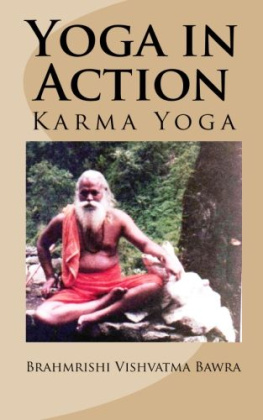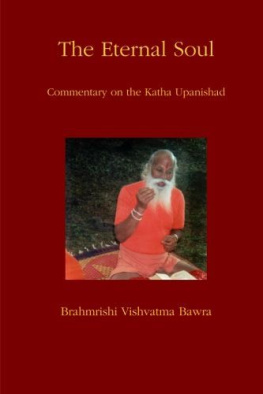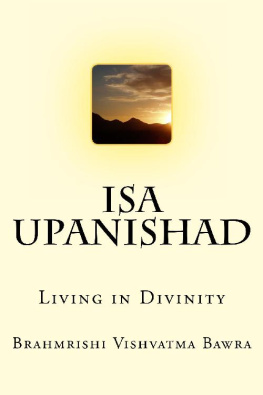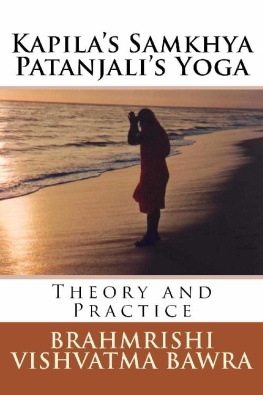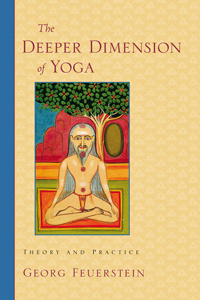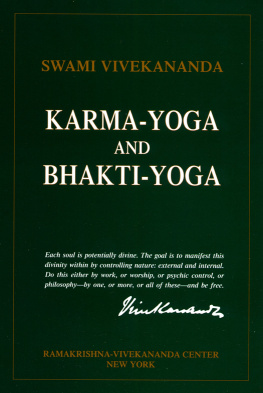Brahmrishi Vishvatma Bawra - Yoga in Action
Here you can read online Brahmrishi Vishvatma Bawra - Yoga in Action full text of the book (entire story) in english for free. Download pdf and epub, get meaning, cover and reviews about this ebook. year: 2010, publisher: Brahmrishi Yoga Publications, genre: Religion. Description of the work, (preface) as well as reviews are available. Best literature library LitArk.com created for fans of good reading and offers a wide selection of genres:
Romance novel
Science fiction
Adventure
Detective
Science
History
Home and family
Prose
Art
Politics
Computer
Non-fiction
Religion
Business
Children
Humor
Choose a favorite category and find really read worthwhile books. Enjoy immersion in the world of imagination, feel the emotions of the characters or learn something new for yourself, make an fascinating discovery.
- Book:Yoga in Action
- Author:
- Publisher:Brahmrishi Yoga Publications
- Genre:
- Year:2010
- Rating:4 / 5
- Favourites:Add to favourites
- Your mark:
- 80
- 1
- 2
- 3
- 4
- 5
Yoga in Action: summary, description and annotation
We offer to read an annotation, description, summary or preface (depends on what the author of the book "Yoga in Action" wrote himself). If you haven't found the necessary information about the book — write in the comments, we will try to find it.
Brahmrishi Vishvatma Bawra: author's other books
Who wrote Yoga in Action? Find out the surname, the name of the author of the book and a list of all author's works by series.
Yoga in Action — read online for free the complete book (whole text) full work
Below is the text of the book, divided by pages. System saving the place of the last page read, allows you to conveniently read the book "Yoga in Action" online for free, without having to search again every time where you left off. Put a bookmark, and you can go to the page where you finished reading at any time.
Font size:
Interval:
Bookmark:
Yoga in Action
Karma Yoga
Brahmrishi Vishvatma Bawra
Lectures on
The Bhagavad Gt and Karma Yoga
Compiled and Edited by
William F. & Margot S. Milcetich
Yogendra & Devhuti
Brahmrishi Yoga Publications
Publisher: Brahmrishi Yoga Publications
BrahmrishiYoga.org
Date: May 2010
Brahmrishi Yoga Publications
All rights reserved
No part of this book may be used or reproduced in any manner without written permission, except in the case of brief quotations embodied in critical articles and reviews.
Printed in United States of America
Library of Congress Control Number: 2010905464
ISBN: 978-1-4528-1656-2
Dedicated to Swami Divya Bharti whose quiet and constant care of Swami Bawras ashram has supported many disciples.
S pecial thanks to Julie Tamarkin, whose mastery of written English and love of philosophy enhance the clarity of Swami Bawras thought.
Preface i
Introduction
Philosophy of Karma Yoga
Verses 1 & 2 13
Verse 3 21
Verse 4 30
Verses 5-7 35
Verse 8 42
Foundation of Karma Yoga
Verses 9 & 10 47
Verse 11 54
Verses 12 & 13 62
Verses 14 & 15 70
Putting Karma Yoga into Practice
S elf-Cultivation 76
Practical Knowledge
Devotion
The Enemy is Desire
Love Seeks its Source
Yagya
Brahmrishi Vishvatma Bawra (1934-2002) is the founder of the International Brahmrishi Mission. Swami Bawras teaching emphasizes that the spiritual science of Brahma Vidya , knowledge of the source of life , has two aspects: theory and practice. In the Upanishads and Bhagavad Gt the theory of this science is called Smkhya, and its practical aspect is Yoga . On the basis of his own experiences, Swami Bawra taught us to realize ultimate truth in order to find freedom from suffering. His teachings are universal and not related with any creed, color, country, community, gender, or sect.
This book is inspired by three series of lectures on the Bhagavad Gt Swami Bawra gave in Kent, Ohio, in 1995, 1997 and 1998. The 1998 lectures are a commentary on the first fifteen verses of the third chapter of the Bhagavad Gt , highlighting the philosophy and foundation of karma yoga . The 1997 lectures were originally compiled in Essays on Karma Yoga . The introduction and the topics in Putting Karma Yoga into Practice are based on these general discussions about karma yoga . The final chapter, Yagya , is derived from the 1995 lectures on the fourth chapter of the Bhagavad Gt , previously compiled in The Nature of Sacrifice .
To assist the English reader with the pronunciation of fr equently used Sanskrit terms, letters have been added to the strict transliteration of Sanskrit to English. For example, citta is written as chitta . Additionally, the long vowels of a, i, and u are indicated by the symbols, , , and . There is no capitalization in Sanskrit, so the use of capitalization is always a deliberate choice. As systems of philosophy, Smkhya , Vedanta and Yoga are capitalized. When the terms smkhya and yoga refer to methods of practice, these terms are not capitalized. Brahman , God, Godhead and Lord are capitalized. Traditionally, the pronoun for formless Brahman is That, and formful Brahman is He. Within the Bhagavad Gt , Krishna is considered an incarnation of Godhead, and use of the pronoun He refers to Krishna as God and as Brahman .
The Vedas are an ancient compilation of universal truth and wisdom. The knowledge in the Vedas focuses on four subject areas, which correspond to four aspects of human life. The first three are related with the head, heart, and hands. Head indicates wisdom, heart represents love, and hands refer to action. The fourth focus is absolute truth, the supreme source of all.
A primary philosophical question is: Why do humans suffer? The Vedas answer: We suffer because we believe we will find happiness in worldly pleasures. We think our happiness depends on transitory situations, people and things. Every circumstance, relationship and possession is temporary. Everything found in human life has a beginning and an end. When these transitory means do not meet our expectations or, worse, when they satisfy us for a while but then change or cease to be, we suffer. The Vedas offer a scientific method to free us from our suffering and lead us toward lasting bliss. The teachings on absolute truth point us toward eternal happiness. Absolute truth is the source of life. Many names have been given to this source, but it remains one, absolute, infinite truth. If we are not aware of this supreme source then we use our head, heart, and hands to pursue transitory objects. But if we are aware of this unchanging, absolute level of existence, and we learn how to act in the world while aiming toward oneness with truth, then we move toward eternal happiness and peace.
Most often, we direct our wisdom, love, and action toward worldly objects, without thinking of absolute truth. When we do this, our love is associated with people and objects; it is temporary and cycles in and out of existence. When a person or object no longer satisfies us, we suffer because our love is lost, and we desire a replacement. This cycle of desire, action, attainment, and loss is endless.
W e act in every moment of life, but we are often unaware of what motivates our actions and we do not understand the consequences of our behavior. Our actions can drag us toward suffering or lift us toward supreme truth. Action or movement is inherent in nature and we cannot live a single moment without it. Our lives are made up of a series of actions: we breathe, we talk, we think, we sleep, we move. Even the decision to resist action is an action. Our choice is whether to act in order to feed the body and senses in a cycle of desire and loss, or to strive toward the highest good of eternal peace and happiness. We have all the means for action: intellect, ego, mind, senses, and body. Nature bestows these tools, which are necessary for experiencing the world and for achieving infinite wisdom and bliss. How we use these instruments depends on our understanding of reality, our motivation for action and our effort. When we are ignorant of truth and our actions are motivated by the external environment, we experience excitement and frustration, desire and fear, temporary pleasure and ultimate suffering in a cycle that spirals downward. But when our actions are inspired by an inner demand for infinite wisdom, we uplift ourselves toward eternal peace. The science of action presented in the Vedas teaches us how to use our human abilities to gain absolute truth.
When we disregard the divine aim of life and remain busy with worldly affairs, we waste the span of life bestowed by divinity. Life is not for accumulation, but for realizing our supreme source. We must understand the goal of life and the means for attaining this aim, and use all of our means to achieve the highest good. We can transform our humanity into divinity through thought, love, and action.
No transformation comes by isolating and developing only one aspect of ourselves: our thinking, emotions, or behavior. Practice includes head, heart and hands, and we use all three to reach toward the supreme source. Knowledge is powerless without application. Love without wisdom is passion or lust. And action without love and wisdom is meaningless. We are humans because of all three, head, heart and hands; all combine on one path to ultimate truth. This path of practice is called karma yoga .
When our intellect and heart are filled with divine knowledge and love, then our actions change from the pursuit of worldly objects to the search for divinity. Yoga is realizing union with the supreme source, which unites us all. We cannot in any moment be separate from our divine source of life, but we disconnect from our awareness of this truth.
Font size:
Interval:
Bookmark:
Similar books «Yoga in Action»
Look at similar books to Yoga in Action. We have selected literature similar in name and meaning in the hope of providing readers with more options to find new, interesting, not yet read works.
Discussion, reviews of the book Yoga in Action and just readers' own opinions. Leave your comments, write what you think about the work, its meaning or the main characters. Specify what exactly you liked and what you didn't like, and why you think so.

